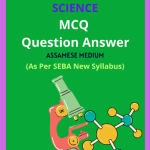Class 8 Science MCQ Chapter 7 Conservation of Plants and Animals Solutions in English Medium, Class 8 Science Multiple Choice Question Answer in English to each chapter is provided in the list so that you can easily browse throughout different chapters Class 8 Science MCQ Chapter 7 Conservation of Plants and Animals Notes and select need one.
Class 8 Science MCQ Chapter 7 Conservation of Plants and Animals
Also, you can read the SCERT book online in these sections Class 8 Science Objective Type Solutions by Expert Teachers as per SCERT (CBSE) Book guidelines. These solutions are part of SCERT All Subject Solutions. Here we have given Assam Class 8 Science MCQs Solutions in English for All Subject, You can practice these here.
Conservation of Plants and Animals
Chapter – 7
| MCQ |
1. Which of the following is an example of an endangered species?
(a) House cat.
(b) African elephant.
(c) Common pigeon.
(d) Rat.
Ans: (b) African elephant.
2. What is the primary goal of conservation efforts?
(a) To increase wildlife trade.
(b) To protect and preserve biodiversity.
(c) To promote deforestation.
(d) To exploit natural resources.
Ans: (b) To protect and preserve biodiversity.
3. Which organization is known for its work in wildlife conservation worldwide?
(a) World Wildlife Fund (WWF).
(b) Red Cross.
(c) Green Peace.
(d) UNESCO.
Ans: (a) World Wildlife Fund (WWF).
4. Which of the following is a major threat to biodiversity?
(a) Natural disasters.
(b) Habitat destruction.
(c) Conservation programs.
(d) National parks.
Ans: (b) Habitat destruction.
5. What is an example of a keystone species?
(a) Bacteria.
(b) Lion.
(c) Dolphin.
(d) Oak tree.
Ans: (b) Lion.
6. What term describes a species that is found only in a specific geographic location?
(a) Endemic.
(b) Migratory.
(c) Invasive.
(d) Introduced.
Ans: (a) Endemic.
7. Which of the following is not a method of conserving plant species?
(a) Bengal tiger.
(b) Asian tiger mosquito.
(c) African lion.
(d) Indian elephant.
Ans: (b) Asian tiger mosquito.
8. What is ‘poaching’?
(a) Sustainable fishing.
(b) Illegal hunting of wildlife.
(c) Wildlife photography.
(d) Wildlife conservation.
Ans: (b) Illegal hunting of wildlife.
9. Which of the following methods is used to conserve endangered animals?
(a) Wildlife reserves.
(b) Industrial development.
(c) Urban sprawl.
(d) Pollution.
Ans: (a) Wildlife reserves.
10. Which type of forest is critical for maintaining global biodiversity and climate balance?
(a) Boreal forest.
(b) Tropical rainforest.
(c) Temperate forest.
(d) Savannah.
Ans: (b) Tropical rainforest.
11. What does the term ‘biodiversity’ refer to?
(a) Variety of human cultures.
(b) Variety of species in an ecosystem.
(c) Number of cities in a country.
(d) Amount of water in rivers.
Ans: (b) Variety of species in an ecosystem.
12. Which conservation strategy involves protecting natural habitats?
(a) Habitat fragmentation.
(b) Habitat protection.
(c) Urbanization.
(d) Land reclamation.
Ans: (b) Habitat protection.
13. What does ‘endangered’ mean in terms of species conservation?
(a) Species with stable populations.
(b) Species at risk of extinction.
(c) Species that are abundant.
(d) Species that have been introduced to new areas.
Ans: (b) Species at risk of extinction.
14. Which of the following is a benefit of biodiversity?
(a) Increased vulnerability to disease.
(b) Loss of ecosystem services.
(c) Stability of ecosystems.
(d) Increased pollution.
Ans: (c) Stability of ecosystems.
15. Which international agreement focuses on the conservation of biological diversity?
(a) Kyoto Protocol.
(b) Paris Agreement.
(c) Convention on Biological Diversity.
(d) Montreal Protocol.
Ans: (c) Convention on Biological Diversity.

Hi! my Name is Parimal Roy. I have completed my Bachelor’s degree in Philosophy (B.A.) from Silapathar General College. Currently, I am working as an HR Manager at Dev Library. It is a website that provides study materials for students from Class 3 to 12, including SCERT and NCERT notes. It also offers resources for BA, B.Com, B.Sc, and Computer Science, along with postgraduate notes. Besides study materials, the website has novels, eBooks, health and finance articles, biographies, quotes, and more.


